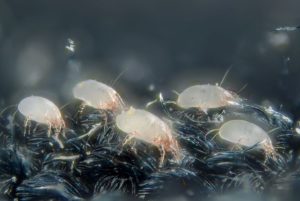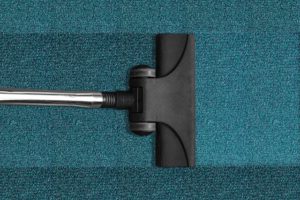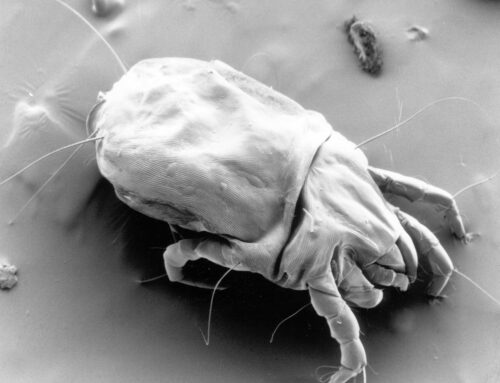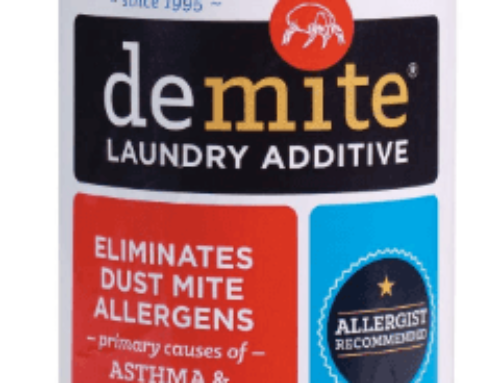Table of Contents
It’s hard to imagine millions of microscopic dust mites crawling on your skin. As creepy as it is, that is the reality that most of us have to deal with. But we often neglect the presence of dust mites until it starts causing problems to us or those of our loved ones.
Up Close With Dust Mites
Dust mites are tiny pests that can be found in most of our homes. As the name implies, dust mites snack on dust or specifically, the dead skin cells that you shed off daily. Under the right humidity (70%-80%) and temperature (68 to 77 Fahrenheit), they can grow exponentially.
This means that you could have millions of dust mites cohabiting your bed and more on the couch, rugs, curtains, furniture, and areas that are likely to gather dust. For most of us, dust mites are not a bother, but for others, dust mites can trigger allergic reactions that demand medical attention.
Can You Feel Dust Mites Crawling On You?
No, you can’t. Dust mites are too tiny that you won’t notice their presence, nor crawling on your skin. But they have ways of making their presence felt.

Running nose, endless sneezes, itchy eyes, and coughing are some of the common allergic symptoms that are associated with dust mites. These happened when you inhale dust mites feces which trigger the allergic reaction.
Dust mites, by itself, apparently does not cause much trouble by themselves, or do they?
Well, if you suffer from eczema or atopic dermatitis, you may want to be cautious of dust mites crawling on your skin. Because they can aggravate the skin condition you’re suffering. Itchiness, cracked and red skin may get worse when you have eczema and exposed to dust mites.
Dust mites wreak havoc on your skin by releasing a protein termed phospholipase A2. This protein functions as an agent to break down the skin cells to physical forms that the dust mites could ingest. In short, dust mites use phospholipase A2 to prepare dinner.
But what triggers the itchiness isn’t the protein or the skin cells that have been broken down. The cause of your skin getting dry and itchy is the reaction of CD1a, molecules that are part of the immune system. As your immune system reacts to phospholipase A2, eczema gets worse.
Here’s the big question. Why some people with eczema suffer from dust mites exposure while those without have little symptoms to show.
Researchers have found that about 30% of people suffering from eczema lack filaggrin. a protective layer of protein that prevents allergens from coming in contact with the skin. Eczema sufferers who lack filaggrin have a higher risk of aggravating skin conditions as they are directly exposed to dust mites.
Do You Have Dust Mites On Your Skin?
If you have eczema, you’ll be concerned about whether the dust mites are eating your skin cells away. I hate to say this but if part of your skin is always sensitive and red, then the answer is yes. The same applies to those who don’t suffer from eczema but with a home ideal for dust mites growth.
You may not be feeling itchy all over, but dust mites can be all over your skin.
The only way to find out for sure is to make an appointment with your doctor and have an allergy skin test conducted. Rather than confirming if there are any dust mites on your skin, the test involves pricking your skin with dust mites extract and observe if any symptoms occur. This is only helpful if you are allergic to dust mites.
Of course, if you insist on knowing for sure if dust mites are having a blast on your skin, you can obtain use clear tape to obtain samples from the skin and place it under a microscope capable of a minimum of 10x amplification.
If you notice hideous creatures with eight legs, no antennae, and whitish in color, then you have the unwelcomed answer to the question. Also, you may notice the greyish fecal pellets which are a fraction of the dust mites size. They are the culprit of common dust mites allergy symptoms.
Can You Rid Of Dust Mites From Your Skin?

It can actually be difficult to literally remove dust mites from your skin. There may be certain ointments or treatments that serve the purpose. But it will be futile if your home is infested with dust mites.
To end, or reduce the agony of dust mites allergy, you’ll want to create an environment that is not conducive to dust mites. This means regulating the humidity in your home with natural ventilation or a dehumidifier.
It also helps to maintain a regular cleaning routine to prevent a thriving ecosystem for the dust mites. Clean the beddings at least once a week to remove dust mites. Setting the dryer to a high temperature helps to kill off the unseen pests.
You’ll also want to pay attention to dust building up in hidden corners of the house and make sure the curtains, rugs, mats, and carpets are regularly vacuumed. And if you’re a fan of stuffed toys, you may want to consider the fact that they are a perfect breeding spot for dust mites too.
Dealing With Eczema
Of course, you’ll want to tend to the irritated skin while you’re battling dust mites at home. The cracked skin can be painful at times if not taken care of. As for the itchiness, try to resist scratching on it, as it could further damage the skin and increase the risks of infection.
Instead, keep your skin moisturized several times a day, particularly in dry weather. Using ointments and cream meant for eczema also helps in keeping the condition under control. Talk to your doctor to get the right ones.
While having a proper stress management strategy also helps with eczema, it is crucial to keep exposure to allergens like dust mites to a minimum. I know it’s tough to deal with eczema and worrying about dust mites. I hope you’ll find the resources on this blog helpful for you.
Does your skin get painfully itchy during certain seasons in the year? Is your home a perfect breeding ground for dust mites? Share your thoughts in the comment below.
Related:




I had an incidence of an heating and air vent opening and falling all over my head and face ..i went to the pharmacy closest to me and he told me it was chiggers ..i put chiggers medicine on it ..wrong move ..i have had this on my face for almost 6 years I really think it’s dust mites and I can’t seem to get rid of it…i have tried EVERYTHING..been to doctors but they don’t seem to be able to figure out what exactly it is…please help me get rid of this
Hi Vicky,
I’m not sure if you’re having bite marks, because dust mites don’t bites. Yet, dust mites can still trigger skin rashes and hives.
Medication helps to soothe the symptoms. But if you’re allergic to dust mites, you’ll want to keep get it under control. This means destroying dust mites and allergen in your home and suppressing their growth.
Dust mites are usually found in great numbers in mattresses and carpets. You’ll need to have bedding and carpet clean very often. Tools like steam cleaners, vacuum, carpet cleaners help in keeping your home free of the little creatures. Placing an air purifier near your bed also helps.
Kenny